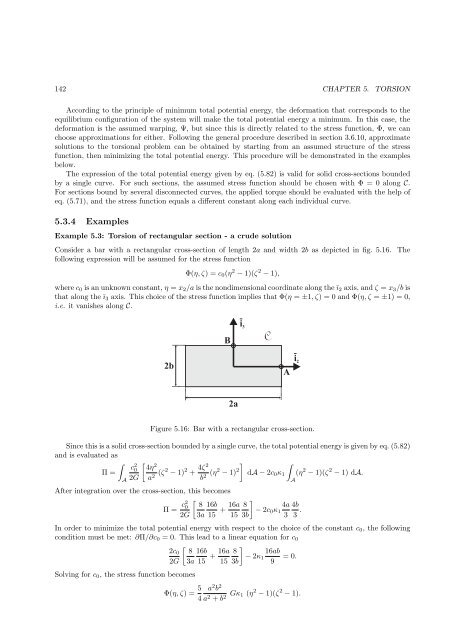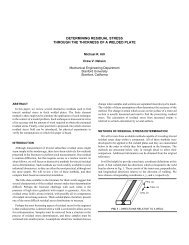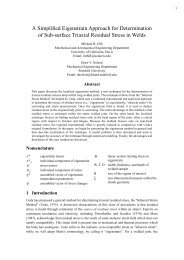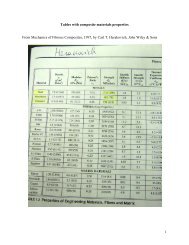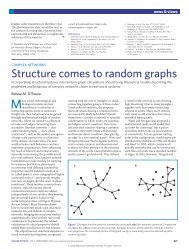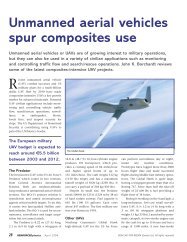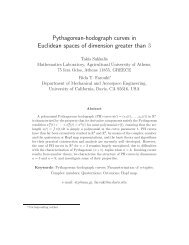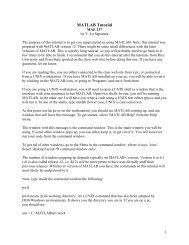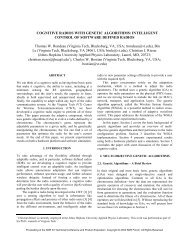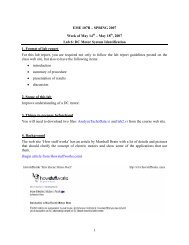Torsion
Torsion
Torsion
You also want an ePaper? Increase the reach of your titles
YUMPU automatically turns print PDFs into web optimized ePapers that Google loves.
142 CHAPTER 5. TORSION<br />
According to the principle of minimum total potential energy, the deformation that corresponds to the<br />
equilibrium configuration of the system will make the total potential energy a minimum. In this case, the<br />
deformation is the assumed warping, Ψ, but since this is directly related to the stress function, Φ, we can<br />
choose approximations for either. Following the general procedure described in section 3.6.10, approximate<br />
solutions to the torsional problem can be obtained by starting from an assumed structure of the stress<br />
function, then minimizing the total potential energy. This procedure will be demonstrated in the examples<br />
below.<br />
The expression of the total potential energy given by eq. (5.82) is valid for solid cross-sections bounded<br />
by a single curve. For such sections, the assumed stress function should be chosen with Φ = 0 along C.<br />
For sections bound by several disconnected curves, the applied torque should be evaluated with the help of<br />
eq. (5.71), and the stress function equals a different constant along each individual curve.<br />
5.3.4 Examples<br />
Example 5.3: <strong>Torsion</strong> of rectangular section - a crude solution<br />
Consider a bar with a rectangular cross-section of length 2a and width 2b as depicted in fig. 5.16. The<br />
following expression will be assumed for the stress function<br />
Φ(η, ζ) = c0(η 2 − 1)(ζ 2 − 1),<br />
where c0 is an unknown constant, η = x2/a is the nondimensional coordinate along the ī2 axis, and ζ = x3/b is<br />
that along the ī3 axis. This choice of the stress function implies that Φ(η = ±1, ζ) = 0 and Φ(η, ζ = ±1) = 0,<br />
i.e. it vanishes along C.<br />
2b<br />
B<br />
2a<br />
Figure 5.16: Bar with a rectangular cross-section.<br />
Since this is a solid cross-section bounded by a single curve, the total potential energy is given by eq. (5.82)<br />
and is evaluated as<br />
<br />
Π =<br />
c2 2<br />
0 4η<br />
2G a2 (ζ2 − 1) 2 + 4ζ2<br />
b2 (η2 − 1) 2<br />
<br />
<br />
dA − 2c0κ1 (η 2 − 1)(ζ 2 − 1) dA.<br />
A<br />
After integration over the cross-section, this becomes<br />
Π = c2 0<br />
2G<br />
<br />
8 16b<br />
3a 15<br />
+ 16a<br />
15<br />
i 3<br />
C<br />
A<br />
A<br />
i 2<br />
<br />
8 4a 4b<br />
− 2c0κ1<br />
3b 3 3 .<br />
In order to minimize the total potential energy with respect to the choice of the constant c0, the following<br />
condition must be met: ∂Π/∂c0 = 0. This lead to a linear equation for c0<br />
<br />
2c0 8 16b 16a 8 16ab<br />
+ − 2κ1 = 0.<br />
2G 3a 15 15 3b 9<br />
Solving for c0, the stress function becomes<br />
a 2 b 2<br />
Φ(η, ζ) = 5<br />
4 a2 + b2 Gκ1 (η 2 − 1)(ζ 2 − 1).


